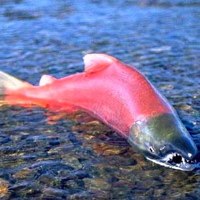Every summer, millions of salmon return to Alaska's streams and rivers to spawn. Alaska has five species of Pacific salmon, all of which are taken by sport, subsistence, and commercial fishermen:
• chum (dog), valued as a food fish.
• king (also called chinook) - official state fish, known for large size
• red (sockeye), distinctive color and delicious flesh
• pink (humpback), recognized by the males' humpback
• silver (coho), known for acrobatic runs after they are hooked.
All salmon are born in fresh water, then travel to salt water. Two or more years later, they return to their home streams to spawn. They are "anadromous fish" (from the Greek for upward (ana-) running (dromos).
Alaska's state fish, the coveted king salmon, is by far the most desired salmon Alaska has to offer. They're the largest and scarcest of the five species of Alaska salmon, bearing the highest amounts of Omega-3 oils of all Alaskan salmon. Because of this high oil content, they are considered to be the richest salmon in the world.
Adult king salmon are typically 25 to 50 pounds with 60 to 80 pound king salmon not uncommon among sport fishermen and commercial catches. They typically range between 2 to 4 feet in length. Because of their size, they're well recognized for their power and endurance. The hook-and-line record is 97 pounds, and the largest king ever caught was a 126-pounder was caught in 1949 in a fish trap near Petersburg in Southeast Alaska.
King Salmon's original name, Chinook, is derived from the tribal name of the Indians that once lived along the Columbia River in Washington State. In the Alaska fisheries. They are also known as Quinnat, Tyee, Black, Chub, Hook Bill, Winter, Blackmouth, Spring, and Jack salmon. Spring salmon are king salmon which ascend rivers in early to late spring. One year old males are called jacks .In scientific terms, king salmon is called "Oncorhynchus tshawytscha". The name Oncorhynchus means hooked snout, and tshawytscha is the name given to these fish by the people of the Kamchatka Peninsula, in Russia. Chinook salmon belong to the family Salmonidae(salmon) and are one of eight species of Pacific salmonids in the genus Oncorhynchus.
Kings have irregular black spotting on their backs and dorsal fins and on both lobes of the tail fin. Kings also have black gums. Seagoing kings are deep-bodied fish with bluish-green coloration on their backs. Spawning kings range from red to copper to almost black. Some kings run all the way up the Yukon River into Canada.
There are two king salmon in Alaska that are very well recognized. First, is the legendary Copper River king salmon known for it's delicious flavor and high Omega-3 content. This king salmon is especially well received for it is one of the first king salmon fisheries that occurs in mid-May every year. It is celebrated all along the Northwest. Secondly, is the Yukon River king salmon. Nothing short of "amazing" describes this prized salmon. It is by far the richest king salmon in the world. Due to the 2200 miles it must swim to reach its breeding grounds, it has a oil content greater than any other salmon in Alaska. Its incredibly delicious meat is marbled with healthy fats and oils like none other. One bite of this and you will be left in complete awe.
Saltwater silvers Oncorhynchus kisutch are bright silver with small black spots on the back. Spawning males develop a prominent hooked snout with large teeth. Spawners of both sexes have dark backs and heads with sides colored maroon to reddish.
Reds Onchorhynchus nerka lack the large black spots found on king, silver and pink salmon. Breeding males develop a humped back and long, hooked jaws filled with sharp, doglike teeth. Both sexes turn brilliant to dark red on the back and sides, pale to olive green on the head and upper jaw and white on the lower jaw. Sockeye flesh is the reddest of the salmon fleshes.
Seagoing chums have metallic greenish-blue backs with fine black speckles. Chums have fewer but larger gill rakers than do other salmon. Once chums reach fresh water, they develop vertical bars of green and purple, and the males develop a hooked snout and very large teeth. Canned chums are often sold outside Alaska as "silver brights."
The pink Onchorhynchus gorbucha is nicknamed "humpback" or "humpy" because of the distinctive hump the male develops at spawning time. This species is the smallest of the five Pacific salmon species. Spawning males develop a brown or black top and white belly; females become olive green with dusky bars or patches and a white belly. Pinks are a major resource for the canning industry. Their distinctive physique makes them a favorite of artists.
|
|







